brianc053
Hero Member
- Jan 27, 2015
- 987
- 3,443
- 🏆 Honorable Mentions:
- 3
- Detector(s) used
- Minelab Equinox 800
XP Deus 2
- Primary Interest:
- Metal Detecting
Hi everyone. My friend SlateBeltDigger invited me to join him earlier this week at a location he had researched, and I just couldn't pass that opportunity up. So I rearranged a few work meetings and met up with him for a few hours yesterday morning at this spot.
The location is now a park but was once a 150-200 acre farm in western New Jersey. The original barn was updated over the decades but the original footprint is visible and preserved as it was long ago, along with some of the surrounding fields. Other areas of the park have been redeveloped into some soccer/football fields, but there's enough of the original land to make the location very interesting.
SlateBeltDigger beat me to the location and was already a quarter-mile across the property when I got there, so I hiked through the tall grass - causing hundreds of grasshoppers to jump away from me as I went. We decided to try the mowed pathways on the fringes of the fields first; they're pretty widely mowed because horses apparently are ridden at this park.
My very first target sounded like a bottle cap in an area SlateBeltDigger had walked through, and I actually asked him "Did you leave a bottle cap behind here?" When he replied "no" I started digging, and that very first target was a tombac button, pictured below.
This tombac is different than any I've seen before (but I'm not thinking it's all that special - just different). It's concave on the front, while most other tombacs I've found are either flat or convex on the front.
Has anyone else found one like this?
The front is rough but the roughness looks intentional; I took a dremmel to the front (gently) and that texture is not corrosion.
Anyway, if you have any thoughts to share (Red-Coat and TheCannonballGuy - I'm looking at you!) about this button I'd love to hear them.
The rest of the hunt was not all that eventful because we were mostly scouting out different areas of the property. The buckle came from near the barn, and when I return to this property I'll be spending more time near there because there were many signals - but I ran out of time and had to head back to work.
Thanks for looking!
- Brian
The park:
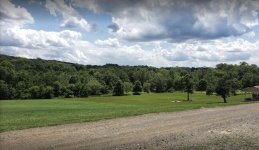
The finds:
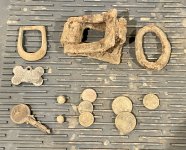
The tombac - backside:
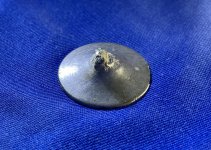
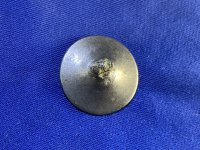
The tombac - frontside:
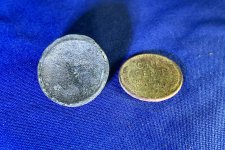
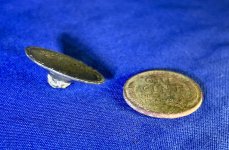
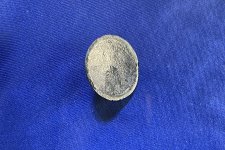
The location is now a park but was once a 150-200 acre farm in western New Jersey. The original barn was updated over the decades but the original footprint is visible and preserved as it was long ago, along with some of the surrounding fields. Other areas of the park have been redeveloped into some soccer/football fields, but there's enough of the original land to make the location very interesting.
SlateBeltDigger beat me to the location and was already a quarter-mile across the property when I got there, so I hiked through the tall grass - causing hundreds of grasshoppers to jump away from me as I went. We decided to try the mowed pathways on the fringes of the fields first; they're pretty widely mowed because horses apparently are ridden at this park.
My very first target sounded like a bottle cap in an area SlateBeltDigger had walked through, and I actually asked him "Did you leave a bottle cap behind here?" When he replied "no" I started digging, and that very first target was a tombac button, pictured below.
This tombac is different than any I've seen before (but I'm not thinking it's all that special - just different). It's concave on the front, while most other tombacs I've found are either flat or convex on the front.
Has anyone else found one like this?
The front is rough but the roughness looks intentional; I took a dremmel to the front (gently) and that texture is not corrosion.
Anyway, if you have any thoughts to share (Red-Coat and TheCannonballGuy - I'm looking at you!) about this button I'd love to hear them.
The rest of the hunt was not all that eventful because we were mostly scouting out different areas of the property. The buckle came from near the barn, and when I return to this property I'll be spending more time near there because there were many signals - but I ran out of time and had to head back to work.
Thanks for looking!
- Brian
The park:

The finds:

The tombac - backside:


The tombac - frontside:



Upvote
16


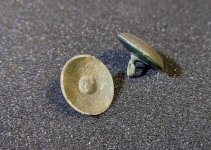



 I've never really counted, but probably less than 20. A lot of them have came from sites that saw 1750s French and Indian War activity, which makes me think they were primarily in use around that time.
I've never really counted, but probably less than 20. A lot of them have came from sites that saw 1750s French and Indian War activity, which makes me think they were primarily in use around that time.




